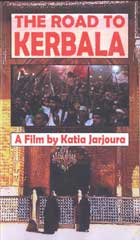
The Road to Kerbala 2005
Distributed by First Run/Icarus Films, 32 Court St., 21st Floor, Brooklyn, NY 11201; 800-876-1710
Produced by Katia Jarjoura
Directed by Katia Jarjoura
VHS, color, 53 min.
Jr. High - Adult
Middle Eastern Studies, Religious Studies
Date Entered: 01/12/2006
Reviewed by Chuck McCann, Florida State University LibrariesThe year is 2004 and videographer Katia Jarjoura travels to Iraq from Canada where she meets poet/novelist Hamid el Mokhtar. In this documentary Jarjoura and Hamid follow along with pilgrims on their way to the city of Kerbala to celebrate Ashura, the most important day for Shi’ite Muslims. From various towns people begin to make their way onto the highway. Along the way on the journey are interesting characters, like the young man with a physical disability who declines a car ride responding, “with walking there are greater rewards.” We see American soldiers who warn pilgrims not to proceed until Improvised Explosive Devices (IEDs) are cleared and the road is safe to continue on. We meet a small boy who chants a prayer who rouses the men to also praise aloud. We witness the friendliness of Iraqis along the way that welcome and lodge travelers as the hours of darkness fall. This pilgrimage was forbidden under the rule of Saddam and the bravery of the pilgrims acting on their new found freedom is inspiring.
Once in Kerbala (also spelled in English, “Karbala”) the celebration begins. In the celebration some of the men re-enact the Battle of Kerbala by singing and marching, some carrying vexillum-style flags that depict the severed head of Husain (also, “Husayn”), grandson of the prophet Muhammad. Other men perform rituals of self-punishment, cutting themselves with swords and striking their backs with heavy flails. Jarjoura and Hamid provide excellent narration and the producers provide attention-grabbing graphical animations to educate viewers on the history of the celebration. This video is a valuable addition for collections in Middle Eastern and Religious Studies, and is highly recommended.